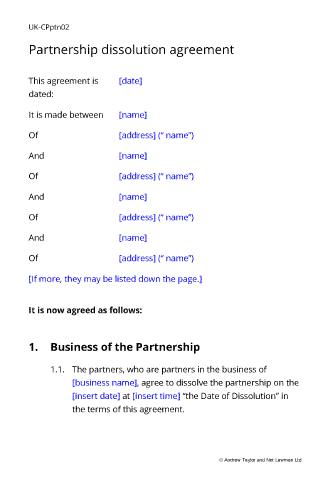
This document is a professionally drawn framework for business partners to wind up their affairs together and formally dissolve their partnership. It covers practical, commercial and administrative points for businesses of any size in any industry.
Compliant with the latest law in
Microsoft Word DOCX Apple Pages RTF
Backed by our watertight guaranteeIf the document isn’t right for your circumstances for any reason, just tell us and we’ll refund you in full immediately.
Written in plain EnglishWe avoid legal terminology unless necessary. Plain English makes our documents easy to understand, easy to edit and more likely to be accepted.
Guidance notes includedYou don’t need legal knowledge to use our documents. We explain what to edit and how in the guidance notes included at the end of the document.
Support from our legal teamEmail us with questions about editing your document. Use our Lawyer Assist service if you’d like our legal team to check your document will do as you intend.
Up to date with the latest lawOur documents comply with the latest relevant law. Our lawyers regularly review how new law affects each document in our library.
The dissolution of your business partnership might occur for any number of reasons. The partners might no longer work together, but you might also be restructuring the partnership's business (such as incorporating it into a company) or changing focus.
A partnership dissolution agreement (also known as a partnership termination agreement) provides written evidence of how you agree to wind up the partnership, helping to protect against disputes later on, setting out responsibilities transparently and determining how the business assets and liabilities are to be divided between the partners.
This is a professionally drawn, easy to use agreement designed to give you the legal and commercial framework you need for tying up the most important of the loose ends when you go your separate ways.
Most importantly, it is a written agreement that negates the provisions for dissolution as contained in the Partnership Act 1890, most of which do not reflect how businesses operate today.
The agreement covers points such as what each partner will buy out of the business, who (if anyone) takes over the business, and how debts and assets will be divided.
This document can be used to record the final agreement, but it also makes a good discussion document or heads of terms for your talks about separation. Winding up any business can be stressful and time consuming. This agreement will enable you first to identify, then to deal simply and quickly with the main issues.
This agreement is ideal for small partnerships (less than ten partners) but could be used for larger ones as well. It can be used for businesses in any industry, from accounting to architecture to trades.
It used to be common to use a deed to record the dissolution. However, a deed is only necessary if the original partnership agreement was created by deed. Since most modern partnerships come into existence by an agreement under hand, an agreement such as this one can be used.
The dissolution date is the date on which the partnership ceases to exist. It is often the effective date of the agreement.
However, there may be work that needs to be done to end the business completely. This might include finishing work in progress, settling debts, selling partnership assets and completing other paperwork. The winding-up date is the date when all of this is complete.
Using the assets of the partnership, debts should be repaid first. These may include taxes owed and amounts borrowed from external lenders such as banks.
Then debts to partners can be repaid, including interest income due on capital and loans.
Undrawn partner profits usually take precedence to repaying longer-term partner loans, but treatment will depend on the terms of any loans.
Original capital contributions can then be returned before remaining profits are distributed.
If the value is in assets (and not in cash), then partners may choose either to receive value owed to them in cash (necessitating the sale of the partnership's assets) or in the remaining assets at an agreed valuation.
Partnership records should be kept as long as necessary by law.
Accounting records must be kept for 7 years. Other documents might be kept for a shorter period. Records that contain personal data (whether relating to customers, employees, partners or suppliers) should be destroyed as soon as the basis for keeping that information changes. For example, some information relating to customers might be required to be destroyed by the wind-up date.
The partners should appoint one of them to be responsible for keeping the accounting records. This person may or may not be the liquidating partner, who remains responsible for other aspects winding up the business.

We are happy to answer any questions you have. Arrange for us to call you.